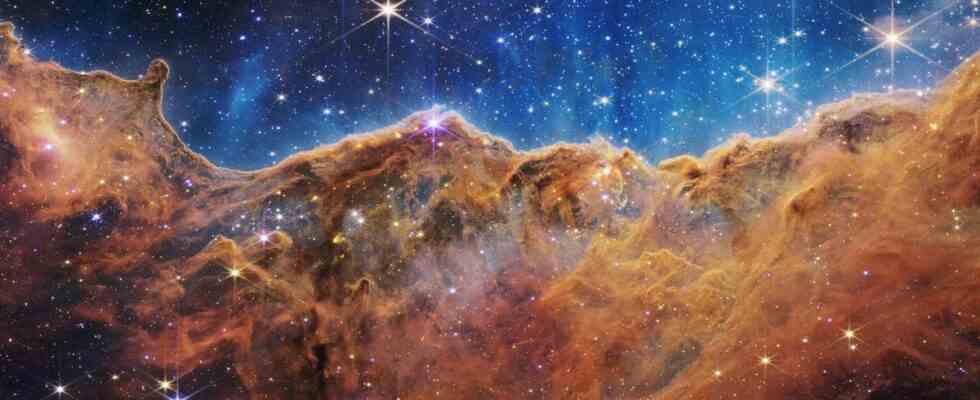A tiny part of the sky, no bigger than a grain of sand held at arm’s length from the ground but which, thanks to the James Webb telescope (JWST), reveals thousands and thousands of galaxies, with more different shapes from each other. The pictures unveiled since Monday by the largest space telescope, positioned 1.5 million kilometers from Earth, allow us to see galaxies that are 13 billion light-years away and give an idea of the Universe just after the Big Bang.
The first image unveiled by Joe Biden on Monday evening shows the galaxy cluster SMACS 0723, observed for 12.5 hours by the telescope. What looks very much like bright crosses are stars and the spirals and other bright dots are galaxies, a planet being a tiny part of this tiny dot. What a way to feel tiny. And to give work for years to all the astronomers who have been working on Hubble data until now.
From the origins of the planets to the death of a star
“In one pixel of this picture, we have hundreds of thousands of solar systems, it gives us a view of a slice of the Universe and tells us about its structure. Webb is a time machine, looking far into the past and seeing the object as it was 13 billion years ago. The Spitzer telescope was already observing in the infrared, with James-Webb we are going to have a finesse of size increased by eight. It’s as if we went from an impressionist painting of the Universe to a realistic painting or as if we put glasses on a nearsighted person, everything is clearer”, explains Olivier Berné, CNRS researcher at the Institute for Research in astrophysics and planetology of Toulouse (IRAP).
These infrared images, the deepest and sharpest of the distant universe to date, therefore open up new perspectives. Thanks to its 6.5 m mirror, the JWST makes it possible to see more details and the faintest objects ever observed.
This Tuesday, while the other first images of the telescope are unveiled at the other end of the Earth by NASA, Olivier Berné is delighted with his first signals, which are already very promising. Especially since his team is one of thirteen whose international program has been selected to use the data collected by James-Webb. In September, for forty hours, the telescope will point to their subject of study, the orion nebulaa nursery of stars.
Images of Stephan’s Quintet 290 million light-years away
While waiting to be able to discover what it has in store for him, the Toulouse researcher will be able to look into one of the other shots of the day: the carina nebula. “She is a little similar, but further. With that of Orion, we will have more details on planets which are from 10 to 100,000 years old, which is nothing compared to the age of our solar system. Watching them is a way to go back to the question of our origins, I am convinced that it will lead us to have new questions about the origin of life. With the observation of the Austral Ring Nebula, a star at the end of its life, it is also a representation of what the sun will become at the end of its life”, continues the astrophysicist.
This expanding cloud of gas surrounds a dying star and is 2,000 light-years from Earth. Much further away, nearly 290 million light-years away, the JWST picked up Stephan’s Quintet.

Behind this poetic name hides a group of galaxies which is in the constellation of Pegasus, observed for the first time by the Frenchman Edouard Stephan in 1878. Made up of billions of stars, they are outside our Milky Way. “It allows us to understand how the Universe was formed, how it evolves and the interaction between the large stars. When two galaxies meet, the stars cross but do not collide. There is a majestic side”, assures Simon Pujol, mediator at the Space City which has created a space dedicated to news about the James-Webb telescope.
Soon, thanks to the observation of the gas giant planet WASP-96b, we will learn more about the chemical composition of its atmosphere, the presence of certain molecules, and why not the discovery of water or sodium. . And why the habitability of other planets. So much information and snapshots that will gradually completely reconstruct the representation of the cosmos that we have, mostly from the images that Hubble has given us in recent years.

